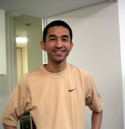イントロダクション
ネオランドスケープ 見られえぬ風景との対話
岡部あおみ(αMプロジェクト2005キュレーター)
「雪山とか森林とか、日本の作家にはまず描けないでしょう?」
近藤正勝の友人のアーティストが問い掛けた。
日本で現代アートの作家として絵画制作をするなら、通常、写実的な筆致で風景や花やヌードなどは描かない。日展など、いわゆる美術団体系の画家との基本的なボーダーが、まずこうしたモチーフと手法にあるからだ。そのために日本の現代アートの絵画には、村上隆や奈良美智のようにスーパーフラットに漫画やアニメ的な主題を描いたり、白い空間を引き立てた美的でデザイン性の高い抽象絵画が多くみられる。
「ロンドンで勉強したからだろうけど、英国の絵の具が違うからなのかなー?」
再現性のある描法で描いた風景なのに、近藤正勝の絵が現代アートとして成立する不思議さを、友人の作家は首をかしげながら自問する。
海外ではほとんど知られていないが、日本の美術は国内市場をもつアカデミックな団体展の方向と、国際派といわれながらもマイナーにとどめられている現代アートに分断されて共存している。とりわけ絵画は、さらに日本画と洋画(油絵)に分類される。交わることのない領域社会で、描く行為のダイナミズムは制限されることはないのだろうか。
こうしたタブーを侵犯し、超然としている近藤正勝の絵画との出会いは、これらの問題が明確に提起される機会にもなる。描くという行為は、近藤によれば「記憶の中に眠っている抽象的なものを確認する」ことだ。迫真したリアリズムとも異なる特異な現前性が立ち現れるのは、写真を使用する独自な方法とプロセスにもよるのだが、不特定の場(時空間)への変容は、風土というナショナル・アイデンティティの脱構築を通した原初的な「風景」への言及が存在するために他ならない。
登ることを拒否する雪山や鬱蒼とした森林といった初期のモチーフは、描くという野生への挑戦だったはずだ。人間の記憶の深層にある自然のフォルムへの認識は、近藤によれば、私たちが日常的に体験しているヴァーチャルなイメージのリアリティでもある。
緻密な技術を駆使し、自由な筆致で、線と面の境界をあいまいにしつつ、具象と抽象を交合させる実験に挑む。長年手がけたアクリル画から、2004年に油絵に変わり、緊迫した未知の発見が繰り広げられる。伝統的な油彩表現のリスクを突き抜け、自律した世界に到達するとき、私たちは「絵画」というリアリティの醍醐味に対峙することになる。
近藤と同世代のピーター・ドイグをはじめとする英国の絵画の動向は、かつてない爛熟した域に達している。こうした芳醇な絵画の状況をネオランドスケープと呼んでもいい。ターナーに始まる風景画だけではなく、連綿と続く肖像画の歴史も英国は継承している。
だが豊かな英国の絵画の土壌を背景としながらも、異邦人である近藤の位置はつねに越境を前提とする。彼にとっての「風景」は、さまざまな見えざるボーダーを可視化し、そのフェンスを跳躍する身体的フィールドのようにも思える。その終わりなき絵画への探求に心から喝采を送りたい。
Neo-Landscape: A Dialogue with Landscapes That Cannot Be Seen
Aomi Okabe(curator of αMproject 2005)
"Japanese artists are not usually able to paint things like snowy mountains or forests, are they?" This question was posed by an artist friend of Kondo Masakatsu.
Painters who work as "contemporary" artists in Japan do not usually paint landscapes, flowers, or nudes with realistic techniques. In fact, these subjects and techniques form a basic borderline between progressive artists and conservative artists belonging to artists' associations such as Nitten (Japan Art Association). Contemporary painting in Japan includes the "superflat" style of Murakami Takashi or Nara Yoshitomo, treating motifs taken from cartoons and animated films, and highly aesthetic, design-oriented abstract paintings that make effective use of white space.
Kondo's friend added, "It may be because he studied in London, and perhaps painting materials are different in England."
Something that is not well known about the Japanese art world is that it is divided between established, academic artists' associations whose works sell domestically and contemporary artists, who have a limited audience at home even though they are referred to as "international." The art of painting in Japan is also divided into Japanese-style painting and Western-style (oil) painting. These Japanese painting societies are territorial, and there is little contact between different areas. This situation limits the possibilities for dynamism in the act of painting.
An encounter with the paintings of Kondo Masakatsu, who has broken and transcended the taboo against realistic landscape painting, provides an opportunity to consider these issues with greater clarity. According to Kondo, the act of painting is "confirming the abstract things sleeping in the memory." A peculiar presence emerges in his work that is different from true-to-life realism because of a unique process based on photography. The painting is transformed into an unspecified place (space-time) by making a reference to primal landscape and deconstructing the sense of climate and place that determines national identity.
With the motifs Kondo used in his early work, unclimbable snowy mountains and dense, dark forests, he was exploring the wild regions of painting. At the same time, according to Kondo, the awareness of the forms of nature in the depths of human memory is a reality of the virtual images that we experience on a daily basis.
With delicate technique and free-wheeling brushwork, he blurs the boundary between line and plane, and experiments with a mixture of abstraction and representation. In 2004, he changed from the acrylic medium he had been using for many years and switched to oil, continuing to make discoveries of the unknown. When he successfully took the risk of working with conventional oil paint which brought him into an autonomous world, it became possible for us to directly encounter the essential reality of painting.
The trend of English painting that includes Kondo and artists of the same generation like Peter Doig has reached an unprecedented level of maturity. This mellow style of painting might be referred to as "neo-landscape." The history of portraiture has also been developed further along with the landscape painting tradition that started with Turner.
While Kondo's art has been nourished by the fertile soil of English painting, he is in the position of a foreigner, which is always premised on crossing borders. To him, landscape is a field for the body that makes invisible borders visible and makes it possible to leap over these fences. From the bottom of my heart, I would like to applaud his unending exploration of painting.
(Translated by Stan Anderson)

